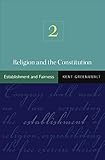Religion and the Constitution : Volume 2: Establishment and Fairness.
Material type: TextPublisher number: MWT13282433Publication details: Princeton : Princeton University Press, 2008.Description: 1 online resource (568 pages)Content type:
TextPublisher number: MWT13282433Publication details: Princeton : Princeton University Press, 2008.Description: 1 online resource (568 pages)Content type: - 9781400828234
- 1400828236
- 1282820915
- 9781282820913
- Church and state -- United States
- Freedom of religion -- United States
- Law
- Electronic books
- Église et État -- États-Unis
- Liberté religieuse -- États-Unis
- Livres numériques
- e-books
- LAW -- Constitutional
- LAW -- Public
- RELIGION -- Religion, Politics & State
- Church and state
- Freedom of religion
- Law
- United States
- 342.730852
- KF4783
- online - EBSCO
| Item type | Current library | Call number | URL | Status | Notes | Barcode | |
|---|---|---|---|---|---|---|---|
 eBook
eBook
|
Biblioteca "Angelicum" Pont. Univ. S.Tommaso d'Aquino Nuvola online | online - EBSCO (Browse shelf(Opens below)) | Online access | Not for loan (Accesso limitato) | Accesso per gli utenti autorizzati / Access for authorized users | (ebsco)340186 |
Browsing Biblioteca "Angelicum" Pont. Univ. S.Tommaso d'Aquino shelves, Shelving location: Nuvola online Close shelf browser (Hides shelf browser)

|

|

|

|

|

|

|
||
| online - EBSCO Religion and society in early modern England : a sourcebook / | online - EBSCO Religion and society in Middle Bronze Age Greece / | online - EBSCO Religion and the Constitution / | online - EBSCO Religion and the Constitution : Volume 2: Establishment and Fairness. | online - EBSCO Religion and the culture of print in modern America / | online - EBSCO Religion and the obligations of citizenship / | online - EBSCO Religion and the state : Europe and North America in the seventeenth and eighteenth centuries / |
Cover; Title Page; Copyright Page; Table of Contents; Preface; Chapter 1: Introduction; Chapter 2: History; Chapter 3: The Development of Doctrine and Its Significance; Chapter 4: Government Aid to Religion and Promulgating Religious Doctrine; Chapter 5: Religious Words and Symbols in Public Places; Chapter 6: Mild Endorsements and Promotions; Chapter 7: Public Schools: Devotions; Chapter 8: Public Schools: Teaching about Religion; Chapter 9: Public Schools: Teaching Whose Content Rests on Religious Views; Chapter 10: Establishment Clause Tests and Standards.
Chapter 11: Equal Facilities and Freedom of SpeechChapter 12: Chaplains in the Military and in Prison; Chapter 13: Religious Groups Exercising Government Power; Chapter 14: Religious Law and Civil Law: Using Secular Law to Assure Observance of Practices with Religious Significance; Chapter 15: Tax Exemptions and Deductions; Chapter 16: Religion and the Exemption Strategy; Chapter 17: Limits of Accommodation; Chapter 18: Financial Support to Religiou.
Balancing respect for religious conviction and the values of liberal democracy is a daunting challenge for judges and lawmakers, particularly when religious groups seek exemption from laws that govern others. Should students in public schools be allowed to organize devotional Bible readings and prayers on school property? Does reciting "under God" in the Pledge of Allegiance establish a preferred religion? What does the Constitution have to say about displays of religious symbols and messages on public property? Religion and the Constitution presents a new framework for addressing these and ot.
Print version record.


